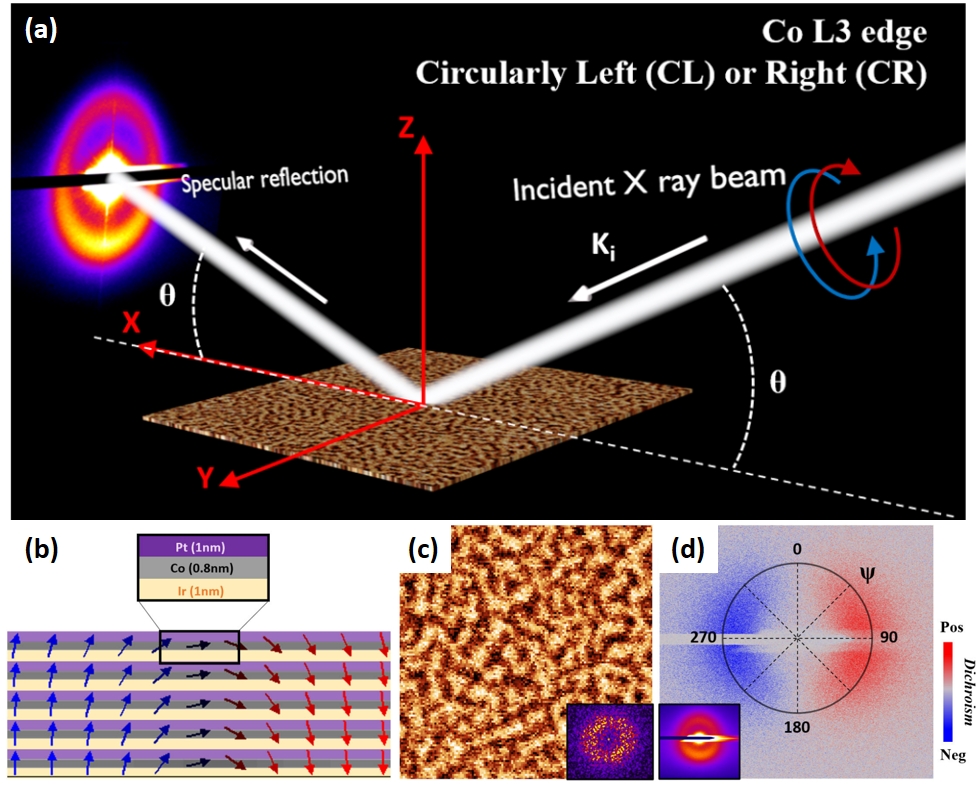Magnetic properties of ultrathin multilayers having a perpendicular magnetic anisotropy (PMA) have been extensively investigated in the 90’s with the promise of huge increase in the storage density.
In a fruitful collaboration between the team of the SEXTANTS beamline and the Unité Mixte de Physique CNRS/Thales in Palaiseau, scientists show that soft X-ray resonant magnetic scattering (XRMS) is a technique particularly adapted to the study of the magnetic textures existing in these multilayers, enabling notably to identify not only the direction but also the sense of the magnetic winding.
These multi-layered systems having a PMA are usually made by stacking thin heavy metal films with thin magnetic one, the prototypical system being Pt/Co. The origin of the PMA is due to the action of the spin-orbit coupling (SOC) at the interfaces, but this interaction has other consequences: The main novelty in these hybrid heavy metal/magnetic metal happens a few years ago when it was realized that the break of the inversion symmetry at the interfaces together with the large interfacial SOC give rise to a strong non-symmetric exchange interaction, the Dzyaloshinskii-Moriya (DM) interaction, as already predicted by Albert Fert in 1990. Importantly, such interfacial DM interaction can be so large that it can generate new magnetic states of matter, all showing a twist of their magnetization configuration with a fixed winding direction defined by the sign of the chiral interaction. The most famous examples are spin spirals, chiral magnetic domain walls or magnetic skyrmions.

Figure 1: XRMS measurement principle and experimental configuration. (a) Actual magnetization texture in the [Ir(1)/Pt/Co(0.6)/Pt(1)]×5 multilayer obtained by micromagnetic simulations. (b) 6 × 6 μm² MFM phase image showing the out-of-plane magnetic contrast of the [Ir(1)/Pt/Co(0.6)/Pt(1)]×5 multilayer with its corresponding FFT pattern (inset) evidencing a 180 ± 30 nm period disordered magnetic stripe pattern. (c) Normalized difference image (CL-CR=CL+CR) evidencing a pronounced magnetic asymmetry.
All the recent key advances on these chiral magnetic systems cannot be summarized in a few lines, but one can mention, among others, the prediction of chiral Néel-domain wall due to this interfacial DM interaction, the only ones that can be efficiently moved by spin orbit torques from spin Hall effects, or more recently the observation of small magnetic skyrmions at room temperature in magnetic multilayers. In fact, part of this strong interest has been motivated by the promise to leverage the unique properties of these new chiral magnetic textures for developing new conceptual devices for future memories and/or spin based logic devices such as the fourth generation of (chiral) domain wall based racetrack memory or different types of skyrmion based devices.
In this study, the scientists demonstrate the ability of soft X-ray resonant magnetic scattering (XRMS) experiments to determine in a straightforward manner, elegant by its simplicity, the actual magnetic textures existing in ultrathin magnetic multilayers with perpendicular anisotropy and large (interfacial) chiral interaction, such as Pt/Co/Ir multilayers.
The main result is that they prove by a thorough but simple analysis of the circular dichroism in XRMS that this measurement enables to identify not only the direction but also the sense of the magnetic winding and therefore the actual sign of the DM interaction. Importantly, and contrary to most existing approaches, this determination does not require any assumptions, measurement or careful comparison to parameter-dependent micromagnetic simulations.
In a broader perspective, the scientists are convinced that dichroism in resonant x-ray scattering can be a unique tool for studying the type and the chirality of the magnetic phase of any ferroic (magnetic, electric, multiferroic) material, and similar investigations could be profitably extended to other systems showing a non collinear electric/magnetic ordering such as skyrmion lattices or conical/helical phases stabilized by the Dzyaloshinskii-Moriya interaction.
European Union Grant FLAG-ERA SoGraph (ANR-15- 356 GRFL-0005) and MAGicSky (FET-634 Open-665095) are acknowledged for financial support.
